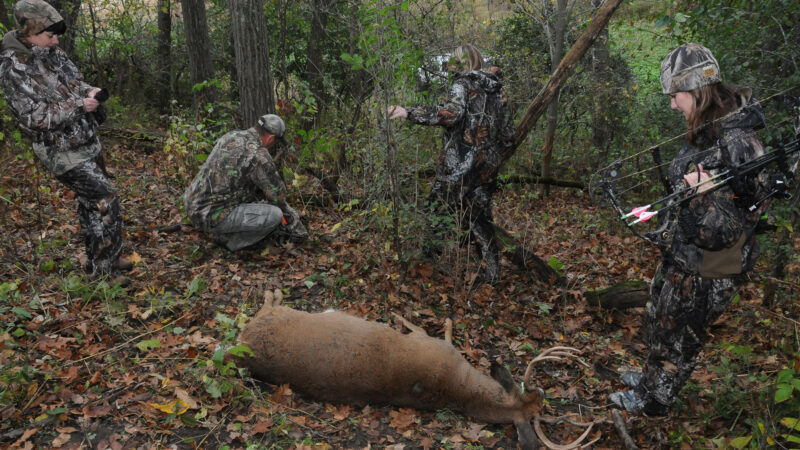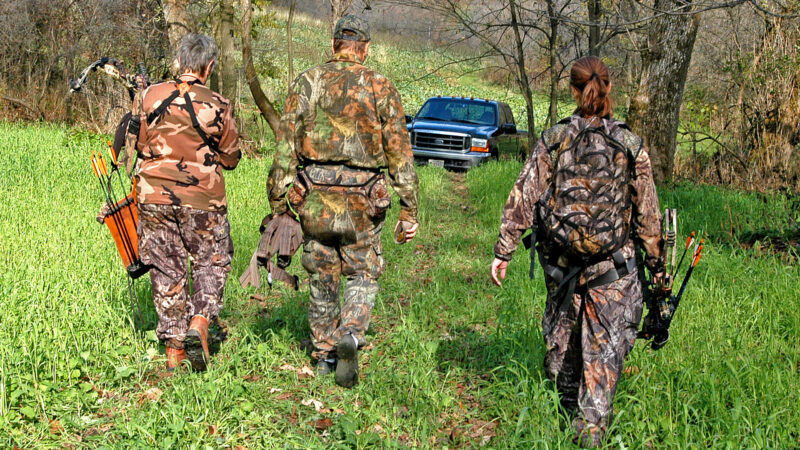Group-hunting has been legal during Wisconsin’s gun deer seasons since the mid-1980s, but four decades later it remains a bridge too far for bowhunters.
Group-hunting, aka “party-hunting” or “group-bagging,” allows members of the same group to shoot and tag/register deer for each other as long as they don’t exceed the group’s total bag limit. Even though group-bagging is technically illegal but commonly accepted in fishing, it’s usually illegal and enforced, or strongly discouraged, in hunting.
But after a loud, public battle in 1984 among Wisconsin hunters, lawmakers and the Department of Natural Resources, the parties compromised to allow group-hunting, but only for firearms deer hunting.

Other states and provinces — such as Minnesota and Ontario — allow group-bagging for archery and firearms deer hunting, but those are exceptions. Iowa, like Wisconsin, allows it only for firearms deer hunting, while Minnesota also allows it for pheasant hunting.
The issue resurfaced during Wisconsin’s statewide conservation hearings in mid-April, and participants supported group-hunting during the archery and crossbow seasons by a 55-45 percentage (5,828-4,695), with 60 counties favoring the expansion and 10 opposing it. Even so, another 5,430 voters marked the “No Opinion” option. With over one-third of voters noncommittal, the issue remained unsettled when the Wisconsin Conservation Congress’s 360 delegates convened May 10-11 in Appleton for their annual convention.
The WCC subsequently rejected the idea when reviewing April’s balloting. Proponents could try reviving the idea as an advisory question for the 2025 statewide hearings, but it would likely fail again without compelling new reasons for change.

After all, this issue has never enjoyed strong support among Wisconsin bowhunters or the WCC, and supporters have never persuaded lawmakers to push it through on their own. Even when proponents found an advocate in the Legislature, the measure fell short. In fact, a state senator tried repeatedly in the 1990s to get fellow lawmakers to back the idea, likely because he never rallied the DNR, WCC or Wisconsin Bowhunters Association to back his bills.
State Sen. Russell Decker, D-Schofield, believed Wisconsin’s bowhunters should be allowed to legally group-bag deer of either sex. In 1999, for instance, he quietly attached an amendment the Senate’s state budget to do just that.
It was at least the third time Decker tried to push the idea into law. Therefore, his amendment hit bitter opposition when longtime foes of group-bowhunting discovered it. In addition to the WCC and WBH, conservation wardens and DNR wildlife managers openly opposed it.
Decker said at the time that he kept trying because the WCC refused to consider the idea during April’s statewide fish and wildlife hearings.
“The Congress (WCC) could do itself and sportsmen a favor by putting this on the ballot,” Decker said in a telephone interview back then. “I’ve asked and they’ve refused. I have different avenues to try.”
Decker, himself an avid bowhunter, said group-bagging would give family and friends more hunting opportunities. He knew the idea was unpopular with the WBH, but questioned the group’s consistency.
“I wonder how many of their members are already group-bowhunting,” Decker said. “We don’t have group-fishing, yet everyone does it. There are a lot of accepted practices in hunting and fishing that aren’t technically legal.”

Even so, other lawmakers told Decker he must remove buck-hunting from his amendment. Rep. DuWayne Johnsrud, R-Eastman, who chaired the Assembly’s natural resources committee in 1999, said Decker’s amendment would fail unless group-bowhunting was restricted to antlerless deer. Johnsrud said the either-sex option for group-bowhunting was a nonstarter.
That was partly because bowhunters had become increasingly buck-oriented since the mid-1980s, and some firearms deer hunters feared archers would shoot even more bucks if group-bagging were legal. In fact, Bill Mytton, then the DNR’s chief big-game ecologist, said group-bowhunting would harm the state’s deer-management system by putting more pressure on bucks.
Mark Houslet, a director in the WBH during the 1990s, agreed with Mytton. Houslet also noted that Wisconsin routinely had thousands of unused and left-over bonus antlerless tags during the 1990s, even though the tags were free in many areas. Therefore, Mytton and Houslet refuted Decker’s contention that bowhunters desired more hunting opportunities.
They also feared group-bowhunting would increase friction between gun-hunters and bowhunters. Many gun-hunters have long criticized Wisconsin’s lengthy archery season. The season lasted nearly three months in 1999, and is even longer today, stretching nearly four months into late January in some regions.
Likewise — right or wrong — some critics have long accused bowhunters of shooting too many bucks in the two months preceding November’s traditional nine-day gun season.
“Group-bowhunting would only give bowhunting’s critics another reason to try shortening the bow season,” Houslet said in an interview 25 years ago. “Our opposition has nothing to do with ethics. We think group-bowhunting would just tick off the gun-hunters.”

Johnsrud also opposed Decker’s efforts because he saw no way to change any hunting regulations that year. Decker inserted his amendment into the budget in July 1999, and the budget process wasn’t expected to end until at least September or October, after the archery season began.
As events unfolded that late summer and fall, Decker’s amendment eventually died.
But as Wisconsin’s conservation community saw again this spring, the idea itself hasn’t died, even though Decker left the Legislature in 2011.

 By
By 



